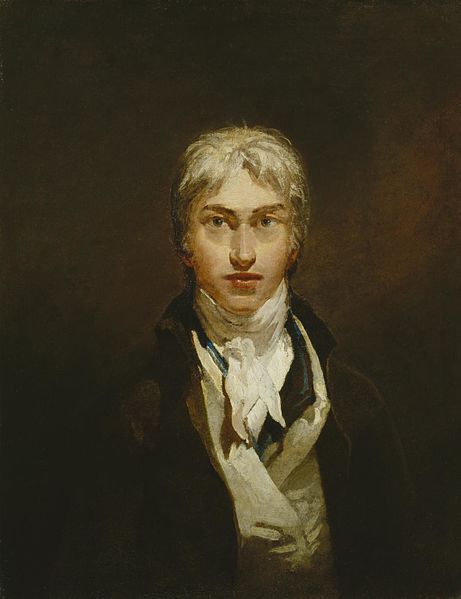
Born: 23 April 1775, London
Died: 19 December 1851 (aged 76)
Period: Romanticism
The Life of Joseph Mallord William Turner
Joseph Mallord William Turnerwas an English painter and watercolourist, renowned for his expressive colorizations, imaginative landscapes, and turbulent, often violent marine paintings. His work is considered a precursor to Impressionism, though he remained deeply rooted in the landscape and history painting traditions of the 18th century. Here’s an overview of his life:
Early Life and Education
- Born on April 23, 1775, in London, Turner showed an early aptitude for art. His father, a barber, exhibited his drawings in his shop window, attracting the attention of potential patrons.
- Turner entered the Royal Academy of Art schools in 1789, at the age of 14, and exhibited his first work there a year later. He rapidly progressed, exhibiting watercolours and receiving commissions.
Artistic Career
- Turner was prolific, creating more than 550 oil paintings, 2,000 watercolours, and 30,000 works on paper. He traveled extensively across Europe, capturing landscapes, seascapes, and historical subjects with a revolutionary approach to light and color.
- His early works were detailed and precise, but as his career progressed, Turner’s style became increasingly free and expressive, focusing on the play of light and atmosphere rather than strict realism.
Major Works and Achievements
- Some of Turner’s most famous works include “The Fighting Temeraire” (1839), which depicts the final journey of a veteran warship being towed to its breaking, symbolizing the end of an era. “Rain, Steam, and Speed – The Great Western Railway” (1844) captures the technological advances of his time.
- Turner was a controversial figure in his day, with critics often divided over his later, more atmospheric and abstract works. However, he was highly respected by many of his peers and was a regular exhibitor at the Royal Academy.
Personal Life and Legacy
- Turner was known to be eccentric, reclusive, and guarded about his private life. He never married, but had relationships, the details of which remain somewhat obscure.
- He died on December 19, 1851, in Chelsea, London, and left a significant portion of his work to the British nation, leading to the establishment of the Turner Bequest, housed at Tate Britain.
- Turner’s legacy is that of one of the greatest landscape painters, whose innovative techniques with light and color influenced the Impressionist movement and continued to inspire artists well into the 20th century.
Joseph Mallord William Turner’s vision and mastery of painting as a medium expanded the possibilities of landscape art, making him a pivotal figure in the history of British art. His works continue to be celebrated for their beauty, emotional depth, and groundbreaking approach to capturing the sublime in nature.
Joseph Mallord William Turner’s Notable Works
Joseph Mallord William Turner is considered one of the greatest masters of British watercolour landscape painting and the precursor to Impressionism. His work is renowned for its vivid depiction of light, atmospheric effects, and sublime landscapes. Here are ten of his most famous works, which capture the essence of his groundbreaking approach to art:
- The Fighting Temeraire (1839) – This iconic painting depicts the HMS Temeraire being towed to its final berth to be broken up, symbolizing the passing of the age of sail. It’s celebrated for its poignant reflection on change and progress.
- Rain, Steam and Speed – The Great Western Railway (1844) – A masterpiece that captures the Industrial Revolution’s impact, this painting is renowned for its dynamic representation of a steam train crossing a bridge, blurring the lines between the elements and the machine.
- Snow Storm: Steam-Boat off a Harbour’s Mouth (1842) – Turner conveys the power of nature and the vulnerability of man in the face of it through this painting, showcasing his mastery in depicting atmospheric effects.
- The Slave Ship (1840) – Originally titled “Slavers Throwing overboard the Dead and Dying—Typhoon coming on,” this work is a powerful condemnation of the transatlantic slave trade, highlighted by its dramatic use of color and light to evoke emotion.
- Dido Building Carthage, or The Rise of the Carthaginian Empire (1815) – This painting reflects Turner’s interest in classical history and his ability to imbue landscapes with narrative depth. It’s part of his ambition to elevate landscape painting to the status of historical painting.
- Sunrise with Sea Monsters (1845) – Although less known, this work is intriguing for its mysterious subject matter and exemplary use of light and color, characteristics that define Turner’s later works.
- The Burnt of Houses of Lords and Commons (1835) – This series of paintings capturing the fire at the Houses of Parliament in London demonstrates Turner’s fascination with the sublime and destructive power of nature.
- Norham Castle, Sunrise (c. 1845) – Turner visited Norham Castle on the River Tweed (on the border of England and Scotland) multiple times, and this painting, one of several depicting the castle, is celebrated for its ethereal quality and exploration of light.
- Venice, from the Porch of Madonna della Salute (1835) – Venice was a frequent subject for Turner, and this painting is one of his most beautiful, capturing the unique light and atmosphere of the city.
- Petworth House, the Library (1827) – Part of a series painted for Lord Egremont at Petworth House, this interior scene is notable for its innovative use of light and shadow, showcasing Turner’s versatility.
Turner’s works pushed the boundaries of painting in his time, blending meticulous detail with evocative and atmospheric effects that would influence the development of modern art. His legacy is a testament to his vision, depicting the natural world’s beauty and terror with unparalleled intensity and emotion.